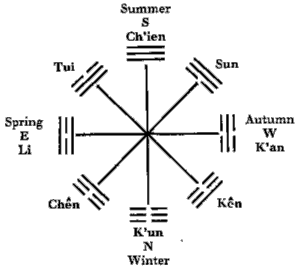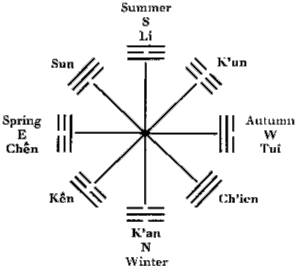Difference between revisions of "Bagua"
m (arrangements) |
(→The two arrangements: some points) |
||
| (6 intermediate revisions by 2 users not shown) | |||
| Line 1: | Line 1: | ||
| + | {{bagua table}} | ||
| + | |||
| + | == The two arrangements == | ||
| + | {{table | ||
| + | |[[Image:Shou kua fig1.gif|thumb|Primal arrangement]] | ||
| + | |[[Image:Shou kua fig2.gif|thumb|King Wen arrangement]] | ||
| + | }} | ||
| + | |||
| + | The primal arrangement (also called the "outer world" arrangement) represents that pattern of things that occur outside, or behind, the manifest world. The King Wen, or "inner world" arrangement is the pattern of things as they occur within the visible world of the manifest in linear space time. | ||
| + | |||
| + | In the outer world arrangement, the pattern operates in a cyclic way that is outside of linear time. All trigrams interact with their opposite partner. In the inner world arrangement, the motion is linear, moving around the circle in one big "yearly" cycle, so the male and female trigrams are grouped together to form the summer and winter phase of the yearly cycle. | ||
| + | |||
| + | Both arrangements appear to have little in common at first glance, but on further inspection some similarities become clear. First every trigram is always directly opposite a partner of the opposite sex in both arrangements. In the primal arrangement, these partners are also of the same ''age''. In both arrangements all vertical partners are also of opposite sex, and therefore the upper and lower horizontal partners are of the same sex. | ||
| + | |||
[[Category:Yi]] | [[Category:Yi]] | ||
| − | |||
| − | |||
| − | |||
| − | |||
| − | |||
| − | |||
| − | |||
| − | |||
| − | |||
| − | |||
| − | |||
| − | |||
| − | |||
| − | |||
| − | |||
| − | |||
| − | |||
| − | |||
| − | |||
| − | |||
| − | |||
| − | |||
| − | |||
| − | |||
| − | |||
| − | |||
| − | |||
| − | |||
| − | |||
| − | |||
| − | |||
| − | |||
| − | |||
| − | |||
| − | |||
| − | |||
| − | |||
| − | |||
| − | |||
| − | |||
| − | |||
| − | |||
| − | |||
| − | |||
| − | |||
| − | |||
| − | |||
| − | |||
| − | |||
| − | |||
| − | |||
| − | |||
| − | |||
| − | |||
| − | |||
| − | |||
| − | |||
| − | |||
| − | |||
| − | |||
| − | |||
| − | |||
| − | |||
| − | |||
| − | |||
| − | |||
| − | |||
| − | |||
| − | |||
| − | |||
| − | |||
| − | |||
| − | |||
| − | |||
Latest revision as of 15:32, 12 July 2021
The two arrangements
The primal arrangement (also called the "outer world" arrangement) represents that pattern of things that occur outside, or behind, the manifest world. The King Wen, or "inner world" arrangement is the pattern of things as they occur within the visible world of the manifest in linear space time.
In the outer world arrangement, the pattern operates in a cyclic way that is outside of linear time. All trigrams interact with their opposite partner. In the inner world arrangement, the motion is linear, moving around the circle in one big "yearly" cycle, so the male and female trigrams are grouped together to form the summer and winter phase of the yearly cycle.
Both arrangements appear to have little in common at first glance, but on further inspection some similarities become clear. First every trigram is always directly opposite a partner of the opposite sex in both arrangements. In the primal arrangement, these partners are also of the same age. In both arrangements all vertical partners are also of opposite sex, and therefore the upper and lower horizontal partners are of the same sex.









